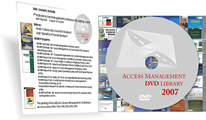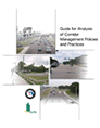Get InvolvedView Strategic Plan in .pdf document If you would like to get involved with our TRB Committee, please contact a subcommittee chair to volunteer your help with a current project. From there you may be asked to join the subcommittee, and then later asked to join the full committee. We need your help and welcome your participation! * Volunteer to serve as a reviewer of research papers, to work on a committee project, or to give a presentation or preside at a session of the annual meeting or a specialty conference. Last updated January 5, 2009 |
![]() 2009 Annual Meeting of TRB Committee ADA70, “Access Management”
2009 Annual Meeting of TRB Committee ADA70, “Access Management”
8:00am-12:00pm, Marriott, Washington B3 January 14, 2009,
Washington, DC
Access Management Committee
![]() Minutes from 2008 mid-year meeting
Minutes from 2008 mid-year meeting
Kristine M. Williams, University of South Florida, presiding ![]() Letter from the Chair
Letter from the Chair
RCM09-033
Monday, January 12, 2009, 8:00am- 9:45am, Marriott, Taylor
National Conference on Access Management Subcommittee, AHB70(1) ![]() Agenda
Agenda
RCM09-034
Monday, January 12, 2009, 10:15am-12:00pm, Marriott, Taylor
Access Management Research Subcommittee, AHB70(2) ![]() Agenda
Agenda
RCM09-035
Monday, January 12, 2009, 1:30pm- 3:15pm, Marriott, Taylor
Access Management Outreach Subcommittee, AHB70(3) ![]() Agenda
Agenda
RCM09-036
Monday, January 12, 2009, 3:45pm- 5:30pm, Marriott, Taylor
Access Management Manual Subcommittee, AHB70(5) ![]() Agenda
Agenda
Paper or Conference Sessions 381
Monday, January 12, 2009, 7:30pm- 9:30pm, Marriott, Thurgood Marshall North
Best Papers from National Conference on Access Management, Part 1 (Part 2, Session 751)
Jeffrey Cleveland Altman, Mississippi Department of Transportation, presiding
Sponsored by Committee on Access Management
(View presentations as given at the 8th National Conference)
Kristine M. Williams, University of South Florida
Herbert S. Levinson, Transportation Consultant
William Edward Frawley, Texas Transportation Institute
Brad Strader, LSL Planning
Road to Access Management in Virginia (P09-0540)
Paul Grasewicz, Virginia Department of Transportation
751 (RCS09-007)
Wednesday, January 14, 2009, 4:30pm- 6:00pm, Marriott, Thurgood Marshall East
Best Papers from National Conference on Access Management, Part 2 (Part 1, Session 381)
Vaughn Lewis, Maryland State Highway Administration, presiding
Sponsored by Committee on Access Management
![]() Effects of Grade on Speed and Travel Time of Vehicles Entering Driveway (09-0954)
Effects of Grade on Speed and Travel Time of Vehicles Entering Driveway (09-0954)
J. L. Gattis, University of Arkansas
![]() Designing and Managing Interchanges in Collaboration with the Public: Interchange Area Management Plan Case Study (P09-0420)
Designing and Managing Interchanges in Collaboration with the Public: Interchange Area Management Plan Case Study (P09-0420)
Marc Butorac, Kittelson & Associates, Inc.
![]() Incorporating Geometric Design into Access Permit Regulations (P09-0422)
Incorporating Geometric Design into Access Permit Regulations (P09-0422)
Philip Demosthenes, Parametrix, Inc.
![]() Prioritizing Access Management Implementation (09-1323)
Prioritizing Access Management Implementation (09-1323)
Grant G. Schultz, Brigham Young University
Kordel T. Braley, Hales Engineering
Tim Boschert, Utah Department of Transportation
Poster Sessions
Monday, January 12, 2009, 9:30am-12:00pm, Marriott, Salon 2
Impact of Access Management Research
Grant G. Schultz, Brigham Young University, presiding
Sponsored by Committee on Access Management
How to Configure One-Way Streets in Urban Road Networks (09-0043)
Xiangdong Xu, Southeast University,China
Lin Cheng, Southeast University, China
Predicting U-turn Volumes at Signalized Intersections Using a Negative-Binomial Model (09-0973)
Tangyi Guo, University of South Florida
Pan Liu, University of South Florida
Bing Cao, University of South Florida
Application of Access Management Technique In HuaiRou Traffic Control Program (09-2259)
Bing Feng Jin, Beijing University of Technology, China
Xiao Kuan Yang, Beijing University of Technology, China
AHB70 Cosponsored Sessions
Wednesday, January 14, 2009, 8:00am- 9:45am, Hilton, Monroe West
Safety and Security in the Metropolitan Planning Organization Planning Process
Kimberly Goins, Federal Transit Administration, presiding
Sponsored by Committee on Metropolitan Policy, Planning, and Processes; Committee on Geographic Information Science and Applications; Committee on Access Management; Committee on Public Transportation Planning and Development
SAFETEA-LU requires metropolitan planning organizations to integrate safety and security considerations into the planning process. FTA and Association of Metropolitan Planning Organizations funded four innovative projects in 2005 addressing a range of safety and security issues. These projects will be showcased, including results and lessons learned. Follow-up discussions provide the audience with a chance to explore issues and opportunities MPOs face when addressing safety and security needs.
Overview of Association of Metropolitan Planning Organization (AMPO)and Federal Transit Administration (FTA) Safety and Security Transportation Planning Incentive Grant Program (P09-0141)
Rich Denbow, Association of Metropolitan Planning Organizations
Emergency Transit Operations Plan for Mississippi Gulf Coast (P09-0051)
Ed E. Elam III, Burke-Kleinpeter, Inc.
Safety Analysis Application: Accident Surveillance System Enhancement and Integration with Transit (P09-0052)
Hector Boggio, Greater Buffalo-Niagara Regional Transportation Council
MPO Approach to Creating Emergency Responders' Uniform Communication System (P09-0053)
Sonya Jackson, North Central Texas Council of Governments
Treasure Valley Access Management Strategy (P09-0054)
Don Matson, Community Planning Association of Southwest Idaho
SMW09-001
Sunday, January 11, 2009, 9:00am-12:00pm, Shoreham, Empire
Graduate Student Research Summaries and Hot Topics in Geometric Design
David R. McDonald, Hanson Professional Services, Inc.; John F. Smart, Institute of Highways and Transportation, United Kingdom, presiding
The workshop is in two parts, with reports on graduate student geometric design research and a discussion of hot topics in geometric design. First, graduate students will report on recently completed or nearly complete dissertations and theses. Next, in Hot Topics in Geometric Design, highlights of geometric design prioritizing, summer research plan activities, and how these interact and support AASHTO and future research will be presented.
Workshop Welcome and Overview (P09-0212)
David R. McDonald, Hanson Professional Services, Inc.
Graduate Student Research Presentations Introduction (P09-0213)
John F. Smart, Institute of Highways and Transportation, United Kingdom
Several Graduate Student Research Presentations - To Be Determined (P09-0214)
Break (P09-0220)
Hot Topic 1 - Geometric Design Overview (P09-0221)
Eric T. Donnell, Pennsylvania State University
Hot Topic 2 - Highways (P09-0222)
James O. Brewer, Kansas Department of Transportation
Hot Topic 3 - Streets and Intersections (P09-0223)
Keith K. Knapp, University of Minnesota
Hot Topic 4 - Methodology (P09-0224)
Ingrid B. Potts, Midwest Research Institute
Hot Topic 5 - Freeways and Interchanges (P09-0225)
Richard C. Coakley, CH2M Hill
View presentations from the TRB 2008 Annual Meeting Sessions
Transportation Planner's Safety Desk Reference
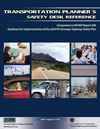 |
A very informative new guide that assists planners in planning for safety on roadways that was passed out at the 2008 TRB annual conference in DC. |
Click here to view .pdf report (May 2007)
Interstate I-394 Business Impact Study
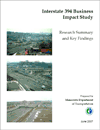 |
This study attempts to capture the economic climate along the corridor both before and after conversion to a freeway. A variety of macro and micro level indicators were used to take snapshots of the corridor’s economic health both before and after freeway conversion.Click here to view .pdf report (June 2007) |
In Section 2.4 some of conclusions were:
- The economic impacts (mainly involving land development and business sales) of
transportation projects have not been researched as extensively as the safety and operational
impacts. - The business impacts studies that have been performed in states such as Florida, Iowa,
Kansas, and Texas have similarly concluded that businesspersons’ perceptions of the
impacts of changes in access on their companies are almost always worse than the actual
impacts as measured after the fact. - Before and after studies of transportation projects involving changes in access indicate that
such projects do not lead to significant increases in business failure rates. - Research also indicates that businesses along and near access-managed corridors do not
suffer inordinate retail sales losses. In fact, businesses along newly access-managed
corridors in Iowa actually outperformed other businesses in their communities in terms of
sales growth. - Literature on the impacts of transportation accessibility on land values suggests that such
impacts would be very difficult to demonstrate either in a positive or negative direction.
Variables such as parcel size and the overall location of the parcel would appear to matter
more.
Direct link to MnDOT Report http://www.olmweb.dot.state.mn.us/pdf/FINAL_I-394_Business_Impact_Study.pdf
Prepared by CH2M HILL and CTRE for MnDOT
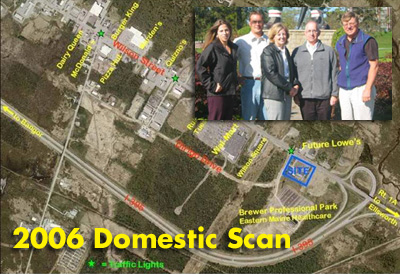 |
2006 Domestic ScanVIEW SUMMARY REPORTIn the fall of 2006, the Federal Highway Administration (FHWA) conducted a domestic access management scan tour. This document provides the results from the tour. FHWA funded the tour to focus attention on access management successes involving local jurisdictions. The scan tour provides good examples that demonstrate the role that local jurisdictions can play in coordinating their transportation planning, development review and permitting process, and comprehensive planning to achieve good access management outcomes. |
County Highway 42 provides a good example of how Dakota County is implementing access management.
The primary function of CH 42 is to accommodate the movement of through traffic (traffic using CH 42 to get to destinations outside of the corridor). However, the high level of commercial development along the corridor has generated large traffic volumes that have raised concerns regarding travel speeds, intersection delays, and motorist safety.
The plan provided a blue print for access management showing where access would be approved, denied, and alternative access provided.
Gateway 1 is an innovative land use and transportation planning project for the Route 1 corridor, from Brunswick to Prospect, Maine , involving approximately 21 towns along a 100 mile corridor. With the careful implementation of access management practices, Maine is preserving quality of life by balancing community growth and local values with transportation needs. Gateway 1 is an extensive project for Maine , and one tool being used is the Memorandum of Understanding. This memorandum was created to solicit agreement from all 21 towns to work together to develop a comprehensive long-range plan, including access management. All 21 towns signed the memorandum and are actively working together to implement access management along the Gateway 1 Corridor as part of this plan.
The City of Brewer , ME’s access management program has taken action in promoting traffic flow along their main corridor by providing for alternative access for local business, requiring shared accesses between businesses, and taking other alternative approaches to reduce any back ups and improve safety on the local roads.
Back to Top
10 Principles
Back to Top
State Websites
 |
Links to Access Management Materials from across the country click here |
Back to Top
Web site Comments, Questions, or Suggestions
Please contact Webmaster
Frank Broen (fbroen@teachamerica.com)
Teach America
121 N Love St
Quincy, FL 32351
(850) 875-0491
fax (850) 875-0490
